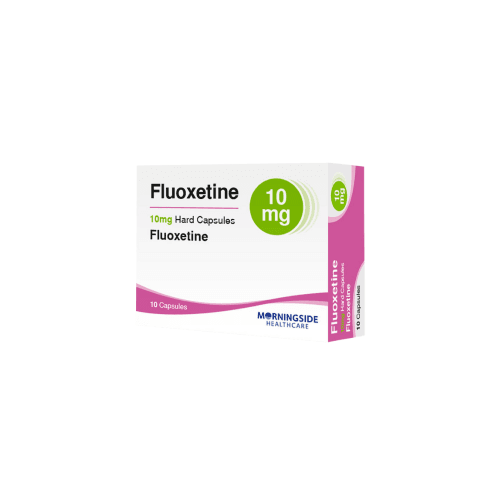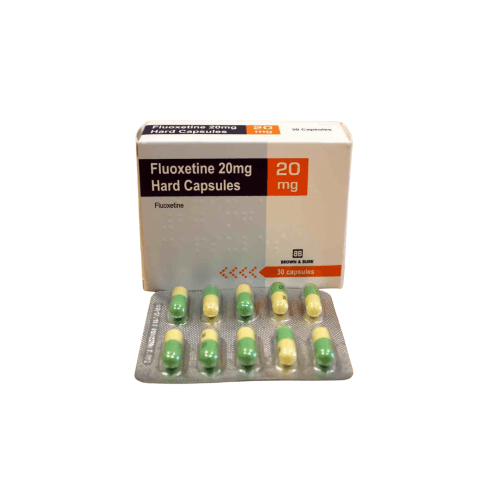Shipping with this method takes 3-5 days
Fluoxetine® Capsules for Depression
Price range: $68.99 through $69.99
Secure Encrypted Payments
Fluoxetine is a selective serotonin reuptake inhibitor used to treat depression and certain anxiety disorders. It has decades of clinical use and broad guideline support. This page helps you understand how the medicine works, how to take it, and what to discuss with your prescriber.
What Fluoxetine Is and How It Works
Fluoxetine® is an SSRI that increases serotonin activity in the brain. It may help improve mood, reduce intrusive thoughts, and ease anxiety. Many patients choose this treatment for access and value, including US delivery from Canada without insurance. YouDrugstore is a licensed Canadian pharmacy in Manitoba. Pharmacists review prescriptions before dispensing.
It works by selectively blocking the serotonin transporter. Over time, this can normalize signaling in mood and anxiety circuits. The class is often taken once daily, and it is generally well tolerated compared to older antidepressants.
Some people use this therapy long term under a prescriber’s supervision. Others need it during episodes, then taper when stable. Follow your clinician’s plan and the official label.
Who It’s For
This medicine is approved for major depressive disorder in adults. It is also used for obsessive-compulsive disorder, panic disorder, and bulimia nervosa when prescribed. For many adults, a fluoxetine 20 mg capsule is a common maintenance dose, though prescribers may adjust based on response.
People with uncontrolled seizures, known allergy to this drug, or those taking monoamine oxidase inhibitors should not use it. Share your full medication list and mental health history with your clinician, especially any bipolar spectrum symptoms or past serotonin syndrome. Explore our condition guides for added context on Depression and Obsessive Compulsive Disorder.
Dosage and Usage
Follow the directions on your prescription label. Many adults take it once daily in the morning, with or without food. Starting doses are typically low and may be increased gradually. A common approach is to begin, monitor for effect and tolerability, then adjust as needed by the prescriber. Some patients use fluoxetine hcl 20 mg once daily; others may require a different schedule.
Swallow capsules whole with water. If stomach upset occurs, taking it with a light snack may help. Try to take it at the same time each day. Do not change your dose or stop suddenly without medical guidance.
Strengths and Forms
This treatment is widely available as capsules and, in some markets, as tablets. Availability can vary by manufacturer and pharmacy stock.
- Capsules: commonly 10 mg, 20 mg, 40 mg
- Tablets: commonly 10 mg, 20 mg
Many generics exist. Your prescription may be filled with a therapeutically equivalent product. Some patients are prescribed a fluoxetine hcl 20 mg tablet, while others receive capsules. Ask your pharmacist if you have questions about the specific manufacturer.
Missed Dose and Timing
If you miss a dose, take it when you remember unless it is close to the next scheduled time. If it is almost time for your next dose, skip the missed one and resume your regular schedule. Do not double up. People switching from or to Prozac 20 mg or other strengths should follow their prescriber’s instructions and the product label.
Storage and Travel Basics
Store in a dry place at room temperature in the original container with the lid tightly closed. Keep out of reach of children and pets. Protect from excess moisture and heat. Do not store in the bathroom.
When traveling, bring enough for your entire trip plus a small buffer in case of delays. Keep a copy of your prescription and your prescriber’s contact information. Use child-resistant packaging and keep the container in your carry-on to avoid temperature swings. If security screening is expected, keep medicines together with documents for easy inspection.
Use the pharmacy label to match the medicine name and your dosing schedule. If you notice damaged or discolored capsules, contact your pharmacist before use. Our site uses encrypted checkout for your protection.
Benefits
As an SSRI, this medicine may help improve mood, reduce worry, and lessen compulsive behaviors. It is generally taken once daily, which can simplify routines. It has a long half-life, which may support steadier levels during missed doses. The therapy is also available as multiple strengths to support individualized plans.
For some conditions, combining this treatment with psychotherapy can provide additional benefit. Your clinician may also consider adjunct options when symptoms persist.
Side Effects and Safety
- Nausea or upset stomach
- Trouble sleeping or sleepiness
- Headache
- Dry mouth
- Increased sweating
- Diarrhea or constipation
- Decreased appetite or weight change
- Sexual side effects
Serious effects are less common but require urgent attention. These can include severe allergic reaction, agitation with worsening mood or suicidal thoughts, unusual bleeding, seizures, serotonin syndrome, or signs of mania. If you experience eye pain with vision changes, seek care, as angle-closure glaucoma can rarely occur.
Drug Interactions and Cautions
Do not use with MAO inhibitors such as linezolid or methylene blue. Avoid thioridazine and pimozide. Combining with other serotonergic drugs, including certain migraine medicines or St. John’s wort, can raise the risk of serotonin syndrome. Use caution with NSAIDs, aspirin, warfarin, or other blood thinners due to bleeding risk. Fluoxetine inhibits CYP2D6, which can raise levels of some medicines and may reduce the effect of tamoxifen.
Limit alcohol. Tell your clinician about liver conditions, seizures, low sodium, bleeding problems, or bipolar history. For more background, see our guide on Drug Interactions.
What to Expect Over Time
Some people feel gradual improvement after consistent daily use. Sleep, energy, or appetite changes can shift first, followed by mood and outlook. Anxiety symptoms may settle as routines stabilize. It is normal for progress to come step by step rather than all at once. If response is partial, clinicians may adjust the plan, add therapy, or consider adjuncts.
Keep your follow-up appointments and report any concerning effects. Use reminders or pill organizers to maintain regular dosing. If stopping is appropriate, prescribers typically provide a taper plan.
Compare With Alternatives
Other SSRIs are options when a different profile is needed. Many prescribers consider Sertraline for depression and anxiety disorders. Another common option is Celexa®, which some patients tolerate well. Your clinician can help select the right approach based on your history and goals.
Pricing and Access
Check our current fluoxetine 20 mg price and compare across available manufacturers. Canadian pricing with US delivery supports value for patients paying cash. If you use discount codes, see our current Promotions. For broader context on therapy choices, review Best Medications For Depression.
We fulfill to all eligible US states. Orders Ships from Canada to US after pharmacist review. Your order history helps you track refills, and our team can coordinate with your prescriber when required.
Availability and Substitutions
Supply can vary by manufacturer and package size. When the exact product is temporarily unavailable, your prescriber may recommend a therapeutically equivalent alternative. Ask your pharmacist about comparable capsule options from different manufacturers if you notice a change in appearance.
Patient Suitability and Cost-Saving Tips
Good candidates are adults diagnosed with major depressive disorder or another approved indication who can take an SSRI safely. Not all patients are suitable. People with hypersensitivity to the drug, current or recent MAOI therapy, or known interaction risks should avoid it. Those with bipolar disorder, seizure history, or liver disease need careful supervision.
To manage costs, consider multi-month fills when appropriate, which can reduce per-fill fees. Set refill reminders so you don’t run out. If paying without insurance, look for manufacturer-independent discounts where allowed. Browse related care areas in our Mental Health category for supportive options.
Dosage Adjustments and Special Populations
Dose changes are clinician-directed. Older adults or people with hepatic impairment may require lower doses. For panic disorder or when sensitivity to side effects is expected, prescribers often start low and increase gradually. Always follow the official label and your prescriber’s guidance.
Questions to Ask Your Clinician
- Starting plan: what dose and time of day?
- When to check in: what signs suggest adjusting therapy?
- Side effects: which are common vs. urgent?
- Interactions: which medicines or supplements should I avoid?
- Duration: how long might I stay on treatment?
- If stopping: how will we taper safely?
Authoritative Sources
Prozac Prescribing Information (Eli Lilly)DailyMed: FluoxetineHealth Canada Drug Product Database
Ready to proceed? View options, see availability, and place your request with prompt, express shipping and US shipping from Canada after prescription review. This information is educational and not a substitute for professional medical advice.
Express Shipping - from $25.00
Prices:
- Dry-Packed Products $25.00
- Cold-Packed Products $35.00
Shipping Countries:
- United States (all contiguous states**)
- Worldwide (excludes some countries***)
Standard Shipping - $15.00
Shipping with this method takes 5-10 days
Prices:
- Dry-Packed Products $15.00
- Not available for Cold-Packed products
Shipping Countries:
- United States (all contiguous states**)
- Worldwide (excludes some countries***)
How long should I stay on fluoxetine after I feel better?
Your prescriber decides duration based on your diagnosis, history, and response. Many patients continue for a period beyond symptom improvement to support stability, then reassess. Do not change or stop therapy on your own. If you’re doing well, ask your clinician when to check in, whether to adjust the plan, and how a taper would work if appropriate.
Can I take fluoxetine at night if it makes me drowsy?
Some people feel energizing effects, while others feel drowsy. If your clinician agrees, taking it at a different time of day may help. Keep the time consistent once you choose it. Avoid alcohol and check for other contributors to sleep changes. Report persistent insomnia or daytime sleepiness to your prescriber.
What if I miss several doses of fluoxetine?
Because of its long half-life, levels decline gradually. Do not double doses to catch up. Resume your regular schedule and call your clinician for guidance if you’ve missed multiple doses or notice symptom changes. If you plan to restart after a gap, follow your prescriber’s instructions and the product label.
Is fluoxetine safe to use with migraine medicines?
Some migraine treatments affect serotonin. Combining serotonergic agents can increase the risk of serotonin syndrome. Share all medicines with your clinician, including triptans and supplements like St. John’s wort. Seek immediate care if you develop symptoms such as agitation, sweating, fast heartbeat, or muscle stiffness.
Can I drink alcohol while taking this medication?
Alcohol can worsen mood, impair judgment, and intensify side effects such as dizziness or sleepiness. Many clinicians recommend limiting or avoiding alcohol during treatment. If you choose to drink, discuss safer limits with your prescriber and monitor how you feel. Never mix alcohol with medicines that depress the central nervous system.
Will fluoxetine affect my other prescriptions?
Fluoxetine inhibits CYP2D6, which can raise blood levels of certain medications. It also interacts with MAO inhibitors, thioridazine, pimozide, anticoagulants, and other serotonergic agents. Share your full list with your clinician and pharmacist. They will check for interactions before dispensing and adjust plans if needed.
What should I watch for in the first weeks of treatment?
Common effects include nausea, sleep changes, headache, or appetite shifts. Most are mild and tend to settle. Rare but serious problems include worsening mood, unusual bleeding, severe agitation, or signs of serotonin syndrome. If you notice concerning changes or suicidal thoughts, contact your clinician right away or seek emergency care.

